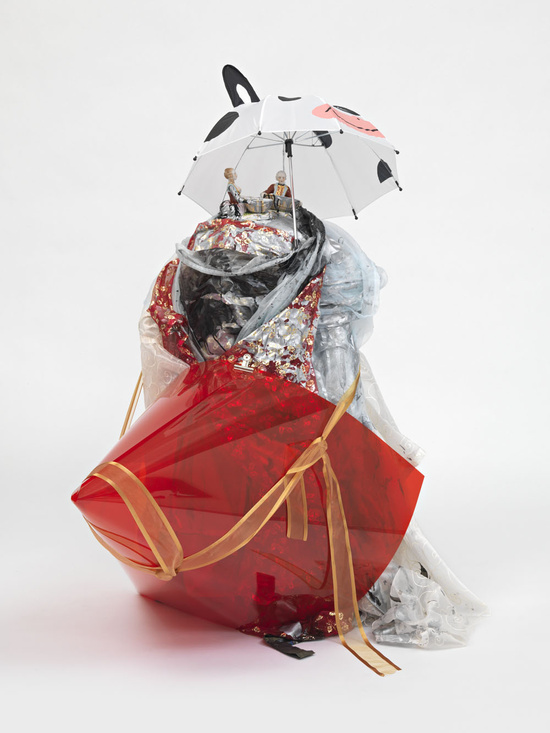I don't believe I had heard of Isa Genzken until I read Peter Schjeldahl's article "VIEWS FROM THE EDGE: An Isa Genzken retrospective" in the New Yorker issue of December 2, 2013, discussing the MOMA retrospective. Thus, I did not know of her artistic involvement with umbrellas until I read Schjeldahl's description of her paternal grandfather:
So, that got me searching for these umbrellas. And they certainly are there! Here sre images of just a few of them: Karl Genzken. A doctor and a committed Nazi, he was the head of the medical office of the S.S. and oversaw experiments on concentration-camp inmates; he was convicted of crimes against humanity at Nuremberg, and died in 1957, three years after being released from prison. According to Der Spiegel, the artist “hinted to” a friend about a childhood visit to her grandfather in prison, where she saw an open umbrella in his cell. Whether that relates to the frequent use of umbrellas in her work seems moot. It’s like Genzken to tantalize with inklings of particular import, which slip away when you try to parse them. . . .
In a 2012 review of her exhibition at the Hauser and Wirth gallery, we are told of how one would enter and encounter:
the startling presence of an enormous unopened garden umbrella [coupled] with a precarious jumble of posters, mannequin heads and modernist furniture. The presence of such a bizarre amalgamation of found objects creates a tangible tension, as each fragment appears to hold a certain significance that can be considered individually as well as part of a whole. The umbrella for example, in its folded and useless state, hangs inanimate. There is a sinister parallel with that of a hanged body, while the non-functioning designer furniture also lays useless on the floor. These sought-after and fashionable items have been rendered obsolete in their installation, allowing for an interesting commentary on the function of consumer driven, hyper-chic possessions in our lives.It is harder to come up with some substantive meaning to it all, however. Some reviewers don't have much respect for umbrellas after all: In Der Spiegel, there is reference to how she "creates beauty from ugly things, even wheelchairs and shabby umbrellas." However, in "9/11 and the Literature of Terror," one work of hers is described [have not found am image to post] certainly suggests that she can use the umbrella in a powerful message:
resonated with themes of 'architecture, power and terror'. To the rear of the plinth on which her materials were assembled, Genzken placed an upturned print of Kurt Hulion's f nous photograph Grand Central Station (l(f'i4). tipped onto its side through ninety degrees, then superimposed on a perforated mesh screen vs tapping the plinth. A sinister figure imposing itself on the right-hand foreground posed ¦Mtwririgly over other figures prone on the plinth. Heaped around the bodies uas an array of found-object motifs suggesting shelter or protection abruptK withdrawn - shoes lost or discarded, a hat, tiny dolls, the umbrella that dominated the piece, its stalk rising out of the amamblage. its metal spokes twisted out of shape, the protet Live dome of the umbrella destroyed by a sudden gust, an explosive blastThis conceit of the lost protective power of the umbrella is powerful art indeed.


